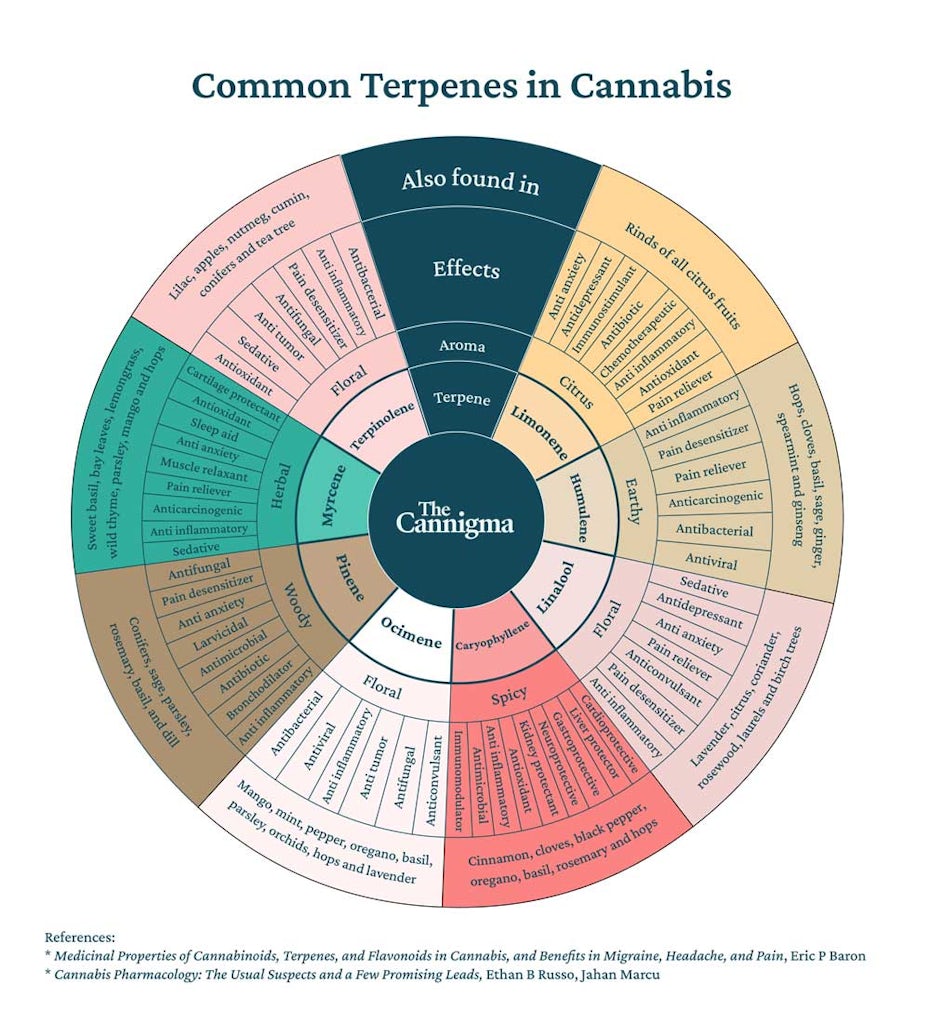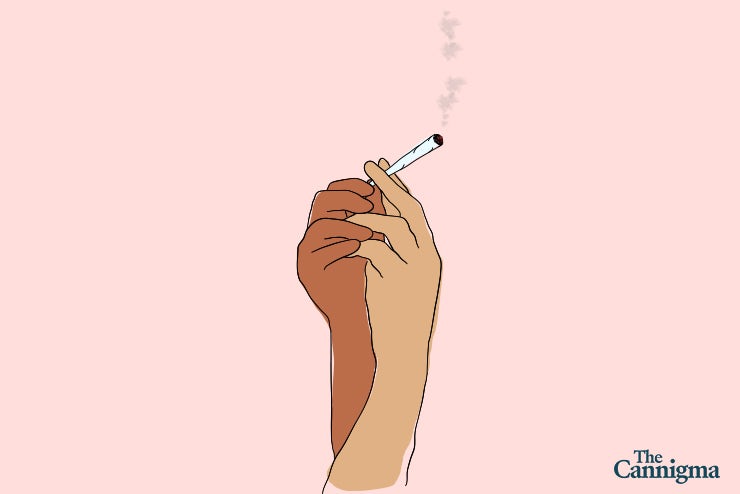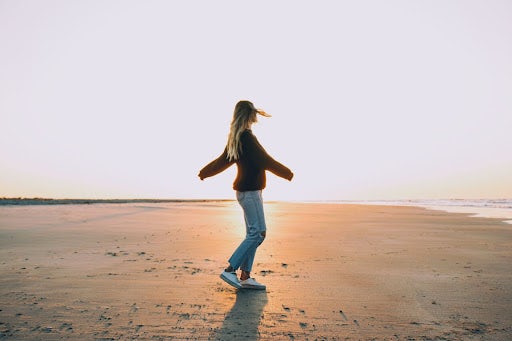Sleep is foundational to good health, impacting our energy levels, cognition, and hormone regulation. Yet despite the obvious benefits, nearly one in three people don’t get enough sleep. 1
Hitting the hay is often listed as a reason why people consume cannabis, but does the science support this?
Research around cannabis is still a young field, and knowledge is changing quickly. There have been some studies around cannabinoids and certain terpenes effects on sleep, but most of this research is preclinical, which means it’s not tested on humans yet.
That doesn’t mean you can’t consume cannabis to improve your sleep, but it does require purposefully trying certain terpenes and cannabinoid ratios, and paying close attention to how different cannabis varieties (strains) affect you. To ensure you’re consuming the best weed strains for sleep, here’s what you need to know.
Cultivars included in this article:
How cannabis can help with sleep
It’s estimated that 35% of American adults get less than seven hours of sleep every night. Prolonged lack of sleep can lead to a variety of health issues, including anxiety, depression, diabetes, and obesity. 2
Depending on your symptoms, cannabis may be able to help you improve your sleep quality.
The endocannabinoid system is an important regulator when it comes to sleep and may play an important role in treating age-related sleep disorders. 3
A 2018 study examined 409 people who self-recorded their cannabis use to combat their insomnia and researchers found that cannabis use had “significant improvements in perceived insomnia.” 4
If you’re dealing with a lack of sleep from an overactive mind, anxiety, or chronic pain,
weed strains with sedating, anti-anxiety, and pain-relieving properties may be able to help you get the shut eye you deserve.
How to choose the best cannabis strains for sleep
Forget strain names, and don’t lose yourself in the indica/sativa debate; these are not reliable indicators of how a strain will affect you. To ensure you’re using the right strain for a good night’s rest, focus on the chemotype and terpene profiles of your weed.
A chemotype is a grouping of cannabis varieties based on their chemical composition, organized by its most dominant cannabinoid. There are three primary cannabis chemotypes:
- Type I: High THC
- Type II: Balanced THC: CBD
- Type III: High CBD
Which strain is best for you really depends more on what sleep issue you’re dealing with and how well you tolerate THC. When it comes to sleep, THC is the workhorse molecule in cannabis. But while it may be the best molecule for sleep, it can also be quite psychoactive at the wrong dose or ratio, and as such it’s not our first recommendation.
While the right cannabis strain for sleep can be hard to find, and vary from person to person, some of the best strains for sleep are Type II variations. These balanced strains provide a dose of THC to help calm your mind and relax your body, while the CBD provides a balancing effect, mitigating some of those THC side effects.
Of course, everyone has a unique endocannabinoid system and a different tolerance to cannabis. A Type I strain may be best for someone who has an overactive mind or is dealing with PTSD, while a Type III may be better for someone who does not like the feeling of THC or is dealing with anxiety. Moreover, some people don’t find Type II cannabis to be sedating enough or simply don’t have access to this type of product, in which case moving to a THC-dominant product is appropriate.
Using cannabis effectively for sleep also depends on your consumption method. If you struggle with falling asleep, having a toke of a Type I or Type II strain 30 – 60 minutes before bed may be the best way to wind down. But if staying asleep is the issue, an edible or some cannabis oil may be better suited to the task. 5
Edibles take longer to take effect, but can last longer in your system, helping you stay asleep longer. The effect will take longer to kick in if you take your cannabis with food, but it will also last longer. For daily sleep maintenance, it’s usually more helpful to turn to tinctures and edibles over flower as tolerance to inhaled flower can build quickly, and the effects typically don’t last as long. Of course, as is always the case in cannabis, there is conflicting evidence and a recent study suggested regular edible use was associated with short sleep duration and overall worse sleep. 6 7
THC and sleep
Type I strains, high in THC, can be helpful for quickly falling asleep and for improving sleep quality for people with chronic pain, and there is some very early (and disputed) evidence that THC could be beneficial in treating obstructive sleep apnea. Additionally, THC is thought to increase deep sleep and reduce REM sleep. 8 9
While a reduction in nightmares is a benefit for someone with PTSD, you shouldn’t rely on THC to the point where you stop dreaming. REM sleep is an important stage in your sleep cycle, and overuse of Type I cannabis can negatively change the way you sleep long term. 10
CBD and sleep
CBD has a biphasic effect, meaning different doses produce opposite results. In low doses, CBD can promote alertness while at higher doses it can cause sleepiness. Using CBD at night can reduce REM sleep disorder behaviors and help with excessive daytime sleepiness. High CBD strains to sleep won’t have the same sedative effect as THC, but it also won’t carry over into next-day grogginess. 11 12 13
Best terpenes for sleep
It may come as a surprise, but scientists have very limited understanding of how and why strains of cannabis affect us differently. One leading theory is that the cannabinoids and terpenes work together to produce unique effects (aka the entourage effect) in the body.
However, we have a very limited understanding and even less evidence to support this theory, mostly thanks to prohibition but also because of the complexity of the topic.

Below are recommendations mostly based on extrapolated animal data and studies on essential oils from plants. In other words, this is a starting point but it’s far from definitive. The most valuable thing you can do to individualize your experience is mindfully consume, monitor how it affects you, and make note of the cannabinoid and terpene profile of the strain used.
Best terpenes to calm your mind
If a racing mind is keeping you up at night, look for these terpenes.
Linalool, myrcene, terpinolene
- In a preclinical study, linalool was found to “induce sedation” by increasing sleeping time and decreasing movement in varying doses. 14
- Myrcene had a sedative and muscle relaxant effect on mice in one preclinical trial. The authors noted at high doses, myrcene could induce anxiety and myrcene is also thought to amplify the effects of THC. 15 16
- Terpinolene extracted from flower oil was identified as a “potent suppressor of the central nervous system” in a 2011 preclinical trial. 17
Best terpenes to relieve stress or anxiety
If stress or anxiety is what keeps you up late at night, seek out these terpenes.
Beta-caryophyllene, limonene, linalool, pinene
- Beta-caryophyllene derived from essential oils had a “central nervous system depressant… and anxiolytic effect” on rodents. Further studies show it was a dose-dependent anti-anxiety effect. 18 19
- Limonene epoxide, a limonene derivative, was identified as a “new approach for the treatment of anxiety” in a 2012 preclinical trial. 20
- Daily inhalation of alpha-Pinene had a “significant anxiolytic” effect in a rodent study. 21
Best terpenes to relieve pain
If chronic pain is keeping you up, reach for these terpenes.
Limonene, pinene, humulene, terpineol
- Limonene exhibited antihyperalgesic effects (reduced sensitivity to pain) in a 2017 preclinical trial. 22
- Alpha-pinene displayed strong anti-inflammatory properties in a study on human cells. 23
- α-Humulene had “marked anti-inflammatory properties” in a preclinical rodent study. 24
- α-Terpineol reduced sensitivity to pain stimuli and reduced inflammation in a rodent study. The authors noted α-Terpineol is “potentially interesting” for new pain management medications. 25
If you don’t have access to the terpene profiles of your cannabis, you still have options. You can purchase terpene isolates to use in conjunction with your cannabis, or you can reach for essential oils. Make sure you’re using essential oils that are food-grade.
Good strains for sleep
Best strains for calming your mind
The best weed strains for calming your mind are Type II chemovars, where the presence of the CBD is high enough to mitigate the effects of the THC, helping you lean into the relaxation without too much anxiety. Strains with this profile include Critical Mass and Harlequin.
Best strains for relieving anxiety
The best strains for relieving anxiety are often Type II or Type III, where the presence of THC is balanced or secondary to the CBD. Avoid strains with myrcene if you’re sensitive to anxiety. Strains with this profile include Canna-Tsu and Harmony Rose.
Best strains to relieve pain
The best strains to relieve pain are typically Type I or Type II, depending on your sensitivity to THC. A balance of CBD can help mitigate some of the spaciness that can come with using THC. Strains with this profile include Bubba Kush and Stephen Hawking Kush.
Sources
- Jane E Ferrie, Meena Kumari, Paula Salo, Archana Singh-Manoux, Mika Kivimäki, Sleep epidemiology—a rapidly growing field, International Journal of Epidemiology, Volume 40, Issue 6, December 2011, Pages 1431–1437, https://doi.org/10.1093/ije/dyr203
- Institute of Medicine (US) Committee on Sleep Medicine and Research; Colten HR, Altevogt BM, editors. Sleep Disorders and Sleep Deprivation: An Unmet Public Health Problem. Washington (DC): National Academies Press (US); 2006. 3, Extent and Health Consequences of Chronic Sleep Loss and Sleep Disorders. Available from: https://www.ncbi.nlm.nih.gov/books/NBK19961/
- Murillo-Rodríguez, E., Budde, H., Veras, A. B., Rocha, N. B., Telles-Correia, D., Monteiro, D., Cid, L., Yamamoto, T., Machado, S., & Torterolo, P. (2020). The Endocannabinoid System May Modulate Sleep Disorders in Aging. Current neuropharmacology, 18(2), 97–108. https://doi.org/10.2174/1570159X17666190801155922
- Vigil JM, Stith SS, Diviant JP, Brockelman F, Keeling K, Hall B. Effectiveness of Raw, Natural Medical Cannabis Flower for Treating Insomnia under Naturalistic Conditions. Medicines (Basel). 2018 Jul 11;5(3):75. doi: 10.3390/medicines5030075. PMID: 29997343; PMCID: PMC6164964.
- Babson, K.A., Sottile, J. & Morabito, D. Cannabis, Cannabinoids, and Sleep: a Review of the Literature. Curr Psychiatry Rep 19, 23 (2017). https://doi.org/10.1007/s11920-017-0775-9
- Campbell LM, Tang B, Watson CW, et al. Cannabis use is associated with greater total sleep time in middle-aged and older adults with and without HIV: A preliminary report utilizing digital health technologies. Cannabis. 2020;3(2):180-189. doi:10.26828/cannabis.2020.02.005
- Winiger EA, Hitchcock LN, Bryan AD, Cinnamon Bidwell L. Cannabis use and sleep: Expectations, outcomes, and the role of age. Addict Behav. 2021;112:106642. doi:10.1016/j.addbeh.2020.106642
- Gorelick, D.A., Goodwin, R.S., Schwilke, E., Schroeder, J.R., Schwope, D.M., Kelly, D.L., Ortemann-Renon, C., Bonnet, D. and Huestis, M.A. (2013), Around-the-clock oral THC effects on sleep in male chronic daily cannabis smokers. Am J Addict, 22: 510-514. https://doi.org/10.1111/j.1521-0391.2013.12003.x
- Ramar K, Rosen IM, Kirsch DB, et al. Medical Cannabis and the Treatment of Obstructive Sleep Apnea: An American Academy of Sleep Medicine Position Statement. J Clin Sleep Med. 2018;14(4):679-681. Published 2018 Apr 15. doi:10.5664/jcsm.7070
- Skobic I, Apolinar GR, Quan SF, Haynes PL. Marijuana versus evidence-based treatments for sleep and relaxation: A cross-sectional study of use and dose modification following involuntary job loss. Sleep Health. 2021 Feb;7(1):113-117. doi: 10.1016/j.sleh.2020.06.008. Epub 2020 Aug 2. PMID: 32758411; PMCID: PMC7855254.
- Shannon S, Lewis N, Lee H, Hughes S. Cannabidiol in Anxiety and Sleep: A Large Case Series. Perm J. 2019;23:18-041. doi: 10.7812/TPP/18-041. PMID: 30624194; PMCID: PMC6326553.
- Babson KA, Sottile J, Morabito D. Cannabis, Cannabinoids, and Sleep: a Review of the Literature. Curr Psychiatry Rep. 2017 Apr;19(4):23. doi: 10.1007/s11920-017-0775-9. PMID: 28349316.
- Nicholson AN, Turner C, Stone BM, Robson PJ. Effect of Delta-9-tetrahydrocannabinol and cannabidiol on nocturnal sleep and early-morning behavior in young adults. J Clin Psychopharmacol. 2004 Jun;24(3):305-13. doi: 10.1097/01.jcp.0000125688.05091.8f. PMID: 15118485.
- Linck VM, da Silva AL, Figueiró M, Piato AL, Herrmann AP, Dupont Birck F, Caramão EB, Nunes DS, Moreno PR, Elisabetsky E. Inhaled linalool-induced sedation in mice. Phytomedicine. 2009 Apr;16(4):303-7. doi: 10.1016/j.phymed.2008.08.001. Epub 2008 Sep 27. PMID: 18824339.
- do Vale TG, Furtado EC, Santos JG Jr, Viana GS. Central effects of citral, myrcene and limonene, constituents of essential oil chemotypes from Lippia alba (Mill.) n.e. Brown. Phytomedicine. 2002 Dec;9(8):709-14. doi: 10.1078/094471102321621304. PMID: 12587690.
- Surendran, S., Qassadi, F., Surendran, G., Lilley, D., & Heinrich, M. (2021). Myrcene-What Are the Potential Health Benefits of This Flavouring and Aroma Agent?. Frontiers in nutrition, 8, 699666. https://doi.org/10.3389/fnut.2021.699666
- Ito K, Ito M. Sedative effects of vapor inhalation of the essential oil of Microtoena patchoulii and its related compounds. J Nat Med. 2011 Apr;65(2):336-43. doi: 10.1007/s11418-010-0502-x. Epub 2011 Feb 3. PMID: 21287406.
- Galdino PM, Nascimento MV, Florentino IF, Lino RC, Fajemiroye JO, Chaibub BA, de Paula JR, de Lima TC, Costa EA. The anxiolytic-like effect of an essential oil derived from Spiranthera odoratissima A. St. Hil. leaves and its major component, β-caryophyllene, in male mice. Prog Neuropsychopharmacol Biol Psychiatry. 2012 Aug 7;38(2):276-84. doi: 10.1016/j.pnpbp.2012.04.012. Epub 2012 Apr 21. PMID: 22542869.
- Volume: 15 issue: 10, Article first published online: October 23, 2020; Issue published: October 1, 2020Received: July 24, 2020; Accepted: September 07, 2020 https://doi.org/10.1177/1934578X20962229
- de Almeida AA, Costa JP, de Carvalho RB, de Sousa DP, de Freitas RM. Evaluation of acute toxicity of a natural compound (+)-limonene epoxide and its anxiolytic-like action. Brain Res. 2012 Apr 11;1448:56-62. doi: 10.1016/j.brainres.2012.01.070. Epub 2012 Feb 10. PMID: 22364736.
- Satou T, Kasuya H, Maeda K, Koike K. Daily inhalation of α-pinene in mice: effects on behavior and organ accumulation. Phytother Res. 2014 Sep;28(9):1284-7. doi: 10.1002/ptr.5105. PMID: 2534018
- Araújo-Filho HG, Pereira EWM, Rezende MM, Menezes PP, Araújo AAS, Barreto RSS, Martins AOBPB, Albuquerque TR, Silva BAF, Alcantara IS, Coutinho HDM, Menezes IRA, Quintans-Júnior LJ, Quintans JSS. D-limonene exhibits superior antihyperalgesic effects in a β-cyclodextrin-complexed form in chronic musculoskeletal pain reducing Fos protein expression on spinal cord in mice. Neuroscience. 2017 Sep 1;358:158-169. doi: 10.1016/j.neuroscience.2017.06.037. Epub 2017 Jul 1. PMID: 28673718.
- Rufino AT, Ribeiro M, Judas F, Salgueiro L, Lopes MC, Cavaleiro C, Mendes AF. Anti-inflammatory and chondroprotective activity of (+)-α-pinene: structural and enantiomeric selectivity. J Nat Prod. 2014 Feb 28;77(2):264-9. doi: 10.1021/np400828x. Epub 2014 Jan 23. PMID: 24455984.
- Rogerio, A. P., Andrade, E. L., Leite, D. F., Figueiredo, C. P., & Calixto, J. B. (2009). Preventive and therapeutic anti-inflammatory properties of the sesquiterpene alpha-humulene in experimental airways allergic inflammation. British journal of pharmacology, 158(4), 1074–1087. https://doi.org/10.1111/j.1476-5381.2009.00177.x
- de Oliveira MG, Marques RB, de Santana MF, Santos AB, Brito FA, Barreto EO, De Sousa DP, Almeida FR, Badauê-Passos D Jr, Antoniolli AR, Quintans-Júnior LJ. α-terpineol reduces mechanical hypernociception and inflammatory response. Basic Clin Pharmacol Toxicol. 2012 Aug;111(2):120-5. doi: 10.1111/j.1742-7843.2012.00875.x. Epub 2012 Apr 11. PMID: 22380944.
Sign up for bi-weekly updates, packed full of cannabis education, recipes, and tips. Your inbox will love it.

 Shop
Shop Support
Support
















